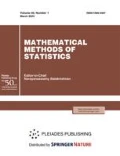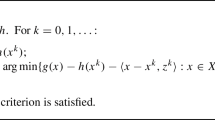Abstract
For a multivariate normal set-up, it is well known that themaximumlikelihood estimator (MLE) of covariance matrix is neither admissible nor minimax under the Stein loss function. In this paper, we reveal that the MLE based on the Iwasawa parameterization leads to minimaxity with respect to the Stein loss function. Furthermore, a novel class of loss functions is proposed so that the minimum risks of the MLEs are identical in different coordinate systems, Cholesky parameterization and full Iwasawa parameterization. In other words, the MLEs based on these two different parameterizations are characterized by the property of minimaxity, without a Stein paradox. The application of our novel method to the high-dimensional covariance matrix problem is also discussed.
Similar content being viewed by others
References
T.W. Anderson, An Introduction to Multivariate Statistical Analysis, 3rd ed. (Wiley, New York, 2003).
R. Askey, “Some Basic Hypergeometric Extensions of Integrals of Selberg and Andrews”, SIAM, J. Math. Anal. 11, 938–951 (1980).
Z. Bai and J. Silverstein, Special Analysis of Large Dimensional RandomMatrices (Springer, New York, 2010).
A. Edelman, “Eigenvalues and Condition Numbers of Random Matrices”, PhD Thesis (Massachusetts Institute of Technology, 1989).
A. T. James, “Distributions ofMatrix Variates and Latent Roots Derived from Normal Samples”, Ann.Math. Statist. 35, 475–500 (1964).
W. James and C. Stein, “Estimation with Quadratic Loss", in Proc. Fourth Berkeley Symp. Math. Statist. Probab. (California Press, Berkeley, CA, 1961), Vol. 1, pp. 361–379.
J. Kiefer, “Invariance, Minimax Sequential Estimation, and Continuous Time Processes”, Ann. Math. Statist. 28, 573–601 (1957).
O. Ledoit and M. Wolf, “Nonlinear Shrinkage Estimation of Large-Dimensional CovarianceMatrices”, Ann. Statist. 40, 1024–1060 (2012).
O. Ledoit and M. Wolf, Optimal Estimation of a Large-Dimensional Covariance Matrix under Stein’s Loss,Working paper ECON 122 (Dept. of Economics, Univ. of Zurich, 2014).
R. J. Muirhead, Aspects ofMultivariate Statistical Theory (Wiley, New York, 1982).
B. Rajaratnam and D. Vincenzi, “A Theoretical Study of Stein’s Covariance Estimator”, Biometrika 103, 653–666 (2016).
C. Stein, “Inadmissibility of the Usual Estimator of the Mean of a Multivariate Normal Distribution”, in Proc. Third Berkeley Symp. Math. Statist. Probab. (California Press, Berkeley, CA, 1956), Vol. 1, pp. 197–206.
C. Stein, Estimation of a CovarianceMatrix, Rietz lecture, 39th AnnualMeeting IMS (Atalanta, Georgia, 1975).
A. Terras, Harmonic Analysis on Symmetric Spaces and Applications. II (Springer, Berlin, 1988).
R. A. Wijsman, Invariant Measures on Groups and Their Use in Statistics, in Lecture Notes–Monograph Series (IMS, California, 1990), Vol. 14.
Author information
Authors and Affiliations
Corresponding author
About this article
Cite this article
Tsai, MT. On the Maximum Likelihood Estimation of a Covariance Matrix. Math. Meth. Stat. 27, 71–82 (2018). https://doi.org/10.3103/S1066530718010052
Received:
Accepted:
Published:
Issue Date:
DOI: https://doi.org/10.3103/S1066530718010052




